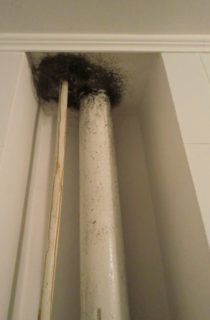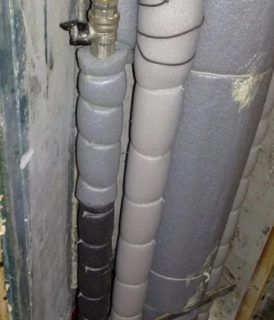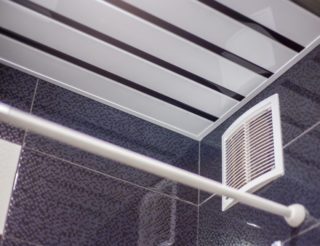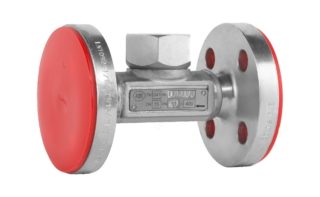Condensation on pipes is very common. Especially a lot of water droplets collect on both metal and plastic products in the summer. This becomes a real problem, as puddles form on the floor, and pipes, due to constant dampness, rust and quickly deteriorate. Also, mold appears on the walls, ceiling and in the corners of the bathroom, which negatively affects human health, causing allergies and frequent respiratory diseases.
Reasons for the appearance
- water leakage from upstairs neighbors;
- poor performance or lack of a ventilation system (constantly closed windows, blockage of the hood);
- malfunction or breakdown of plumbing (mixer, shower, toilet cistern);
- poor-quality pipe insulation or lack thereof;
- ill-conceived configuration in the wiring (pipes for hot and cold water supply are not provided with thermal insulation and are close to each other);
- deterioration of fittings on metal-plastic and polypropylene pipes;
- problems arising during the operation of the building and communications (flooding of basements, emergencies in the water supply and sewerage system, blockage in the ventilation ducts);
- defects during construction (poor-quality thermal insulation of walls, lack of waterproofing of the foundation).
Also, the formation of moisture on pipes is significantly influenced by reasons that are difficult or almost impossible to eliminate. It:
- climate and external weather conditions (areas with high humidity, prolonged precipitation in the form of rain and snow);
- the difference in temperatures on the surface of the pipeline and the air in the room (if the difference in indicators is more than 17 ° C, drops will appear on the pipes);
- geographical features of the area (the presence of large bodies of water near houses, high air humidity in combination with rocky ground).
For whatever reason condensation forms on the pipes, the problem must be identified and eliminated. You can remove moisture from the pipes every day and constantly wipe the resulting puddles on the floor, but in practice it is very long, difficult and unpleasant. At the same time, in most of the hard-to-reach places of the bathroom (under the bath, behind the shower), it is not possible to do this. From which it follows that it is necessary to deal with condensation thoughtfully and thoroughly.
Problem solving methods
In most cases, you can cope with moisture on the pipes yourself, by regulating the ventilation system and providing the pipes with thermal insulation. The solutions to the problem are relatively simple and accessible to everyone.
Thermal insulation device
It is much more expensive, but more efficient to cover pipes with special heat-insulating paint, for example: "Corundum", "Isollat", "Astratek", "Bronya". To do this, you need to apply 4-5 layers of the substance, after each has dried.In the process of work, it is required to ensure good ventilation of the room.
For greater effect, you can combine the 2 above methods. It is also allowed to apply two more layers of paint on top of the energy flex, but on the condition that the material is firmly glued along the cuts.
You can also create high-quality thermal insulation with a putty. For this:
- Clean and dry the surface of the riser or piping.
- Wipe the pipe with acetone and treat with an anti-corrosion agent.
- Brush on with a layer of epoxy putty.
- Wrap the pipe over a damp surface with a cloth.
- Apply a few more coats of putty after each is dry.
- When the last layer is dry, sand the insulation and paint it over.
Ventilation
- Check the ventilation hole for dust, cobwebs, debris.
- If found, remove any dirt with a vacuum cleaner and a damp cloth. If the blockage is deep in the ventilation shaft, contact the UK at home with a request to send a specialist to check and fix the problem. Such work should be done free of charge.
- Install a new, or a well-rinsed and dried old grill, or a special fan to create forced air exchange.
For natural ventilation, leave the bathroom and toilet open overnight. You can drill several holes in the bottom of the door with a drill with a special nozzle or widen the gap above the sill.
A good option for natural ventilation is the installation of plastic windows with micro-ventilation.
Repair of communications
First of all, it is necessary to visually inspect the pipeline in the bathroom, in the kitchen, in the toilet. Leaks are usually visible to the naked eye, but in rooms where pipes are located in walls and ceilings, it is more difficult to identify the problem. To do this, you need to disassemble a drywall box covering communications or call plumbers with special equipment that helps to detect a leak. It is also better to entrust the repair or replacement of risers, wiring, mixer, shower and toilet to professionals.
Installation of steam traps
- float;
- thermodynamic;
- bimetallic.
When choosing and installing such equipment, it is required to take into account different criteria, therefore, it is better to entrust the solution of this task to professionals.
It is necessary to eliminate condensation immediately after droplets of moisture appear on the pipes. If you ignore the problem, it can lead to large financial investments. You will have to change not only the risers and wiring, but also completely finish the bathroom, or worse, pay for repairs to the neighbors.












